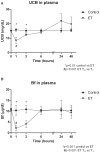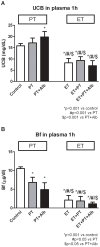Optimizing exchange transfusion for severe unconjugated hyperbilirubinemia: studies in the Gunn rat
- PMID: 24143211
- PMCID: PMC3797100
- DOI: 10.1371/journal.pone.0077179
Optimizing exchange transfusion for severe unconjugated hyperbilirubinemia: studies in the Gunn rat
Abstract
Background: Severe unconjugated hyperbilirubinemia carries the risk of neurotoxicity. Phototherapy (PT) and exchange transfusion (ET) are cornerstones in the treatment of unconjugated hyperbilirubinemia. Studies to improve ET efficacy have been hampered by the low application of ET in humans and by the lack of an in vivo model. The absence of an appropriate animal model has also prevented to determine the efficacy of adjunct or alternative treatment options such as albumin (Alb) administration.
Aim: To establish an in vivo model for ET and to determine the most effective treatment (combination) of ET, PT and Alb administration.
Methods: Gunn rats received either PT, PT+Alb, ET, ET+PT, ET+PT+Alb or sham operation (each n = 7). ET was performed via the right jugular vein in ≈ 20 min. PT (18 µW/cm(2)/nm) was started after ET or at T0. Albumin i.p. injections (2.5 g/kg) were given after ET or before starting PT. Plasma unconjugated bilirubin (UCB), plasma free bilirubin (Bf), and brain bilirubin concentrations were determined.
Results: We performed ET in 21 Gunn rats with 100% survival. At T1, ET was profoundly more effective in decreasing both UCB -44%, p<0.01) and Bf -81%, p<0.05) than either PT or PT+Alb. After 48 h, the combination of ET+PT+Alb showed the strongest hypobilirubinemic effect (-54% compared to ET).
Conclusions: We optimized ET for severe unconjugated hyperbilirubinemia in the Gunn rat model. Our data indicate that ET is the most effective treatment option, in the acute as well as the follow-up situation.
Conflict of interest statement
Figures




References
-
- Calligaris SD, Bellarosa C, Giraudi P, Wennberg RP, Ostrow JD, et al. (2007) Cytotoxicity is predicted by unbound and not total bilirubin concentration. Pediatr Res 62: 576–580. - PubMed
-
- Zucker SD, Goessling W, Hoppin AG (1999) Unconjugated bilirubin exhibits spontaneous diffusion through model lipid bilayers and native hepatocyte membranes. J Biol Chem 274: 10852–10862. - PubMed
-
- Wennberg RP, Ahlfors CE, Bhutani VK, Johnson LH, Shapiro SM (2006) Toward understanding kernicterus: A challenge to improve the management of jaundiced newborns. Pediatrics 117: 474–485. - PubMed
MeSH terms
Substances
LinkOut - more resources
Full Text Sources
Other Literature Sources
Medical
Miscellaneous

